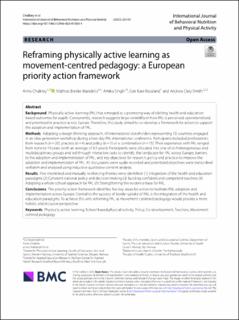| dc.contributor.author | Chalkley, Anna | |
| dc.contributor.author | Mandelid, Mathias | |
| dc.contributor.author | Singh, Amika | |
| dc.contributor.author | Resaland, Geir Kåre | |
| dc.contributor.author | Daly-Smith, Andrew | |
| dc.date.accessioned | 2023-09-15T09:01:52Z | |
| dc.date.available | 2023-09-15T09:01:52Z | |
| dc.date.created | 2023-08-28T14:19:36Z | |
| dc.date.issued | 2023 | |
| dc.identifier.issn | 1479-5868 | |
| dc.identifier.uri | https://hdl.handle.net/11250/3089673 | |
| dc.description.abstract | Background
Physically active learning (PAL) has emerged as a promising way of eliciting health and education-based outcomes for pupils. Concurrently, research suggests large variability in how PAL is perceived, operationalized, and prioritized in practice across Europe. Therefore, this study aimed to co-develop a framework for action to support the adoption and implementation of PAL.
Methods
Adopting a design thinking approach, 40 international stakeholders representing 13 countries engaged in an idea generation workshop during a two-day PAL international conference. Participants included professionals from research (n = 20), practice (n = 4) and policy (n = 1) or a combination (n = 15). Their experience with PAL ranged from none to 19 years (with an average of 3.9 years). Participants were allocated into one of six heterogeneous and multidisciplinary groups and led through interactive tasks to identify: the landscape for PAL across Europe, barriers to the adoption and implementation of PAL, and key objectives for research, policy and practice to improve the adoption and implementation of PAL. All discussions were audio recorded and prioritized objectives were transcribed verbatim and analysed using inductive qualitative content analysis.
Results
Five interlinked and mutually reinforcing themes were identified: (1) Integration of the health and education paradigms (2) Coherent national policy and decision making (3) Building confident and competent teachers (4) Adopting a whole school approach for PAL (5) Strengthening the evidence base for PAL.
Conclusions
The priority action framework identifies five key areas for action to facilitate PAL adoption and implementation across Europe. Central to the success of border uptake of PAL is the integration of the health and education paradigms. To achieve this aim, reframing PAL as movement-centered pedagogy would provide a more holistic and inclusive perspective. | en_US |
| dc.language.iso | eng | en_US |
| dc.publisher | BioMed Central | en_US |
| dc.rights | Navngivelse 4.0 Internasjonal | * |
| dc.rights.uri | http://creativecommons.org/licenses/by/4.0/deed.no | * |
| dc.title | Reframing physically active learning as movement-centred pedagogy: a European priority action framework | en_US |
| dc.type | Peer reviewed | en_US |
| dc.type | Journal article | en_US |
| dc.description.version | publishedVersion | en_US |
| dc.rights.holder | © The Author(s) 2023 | en_US |
| dc.source.journal | International Journal of Behavioral Nutrition and Physical Activity | en_US |
| dc.source.issue | 20 | en_US |
| dc.identifier.doi | 10.1186/s12966-023-01503-4 | |
| dc.identifier.cristin | 2170265 | |
| dc.source.articlenumber | 101 | en_US |
| cristin.ispublished | true | |
| cristin.fulltext | original | |
| cristin.qualitycode | 2 | |

